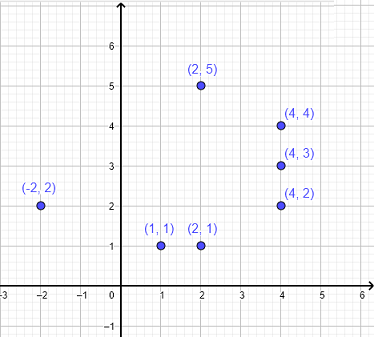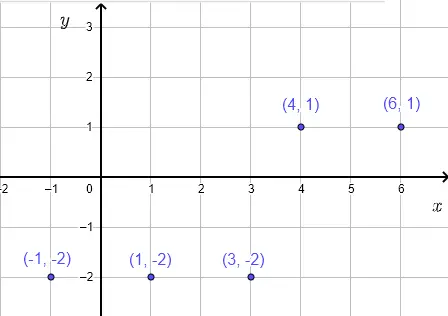
The definition of function in mathematics is presented along with examples, questions and their solutions.
A function from a set \( D \) to a set \( R \) is a relation that assigns to each element \( x \) in \( D \) exactly one element \( y \) of \(R\). The set \( D \) is the domain (inputs) and the set \( R \) is the range (outputs) [1 2].






Functions may be represented by mathematical equations as follows:
a) \( y = 2 x - 1 \) , b) \( y = x^2 + 1 \) , c) \( y = \dfrac {1}{x} \)
All the above equations represent \( y \) as function of \( x \) because for each for each value of \( x \) in the domain, we obtain exactly one value of \( y \).
\( x \) is called the independent variable and \( y \) is the dependent variable.
More on functions represented by equations are included.
The domain \( D \) of a function is the set of all input values for which the output is defined.
The range \( R \) of a function is the set of all output values corresponding to the input values in the domain \( D \).
Example
Find the domain and range of the functions defined in different forms:
a) A Set of ordered pairs: \( \quad F_1 = \{ \; (a,2) \; , \; (b,4) \; , \; (c,7) \; , \; (d,-2) \} \)
b) Venn diagrams

c) A graph

d) An equation: \( \quad y = - x + 3 \) for \( x \) in the domain \( D = \{-3,0,6,7\} \)
Solution to Example
a)
The domain \( D \) is the set of all inputs represented by the first elements in all ordered pairs. Hence \( D = \{ a ,b, c , d \} \)
The range \( R \) is the set of all outputs corresponding to each element in the domain \( D \). Hence; \( R = \{ 2 ,4, 7 , -2 \} \)
b)
The domain \( D \) is the set of all inputs. Hence \( D = \{ 0 ,5, 3 , -3 \} \)
The range \( R \) is the set of all outputs corresponding to each element in the domain \( D \). Hence; \( R = \{ 2 , 0 , 6 \} \)
c)
The domain \( D \) is the set of all inputs represented by the \( x \) coordinates of the points of the graph representing the function. Hence \( D = \{ 2 , 4 , 6 , 7 \} \)
The range \( R \) is the set of all outputs corresponding to each element in the domain \( D \) and represented by the \( y \) coordinates. Hence; \( R = \{ 3 , 1 , 4 , 2 \} \)
d) The domain is given explicitly as: \( D = \{-3,0,6,7\} \)
The range \( R \) is the set of the values of \( y \) calculated by substituting the values of \( x \) in the equation of the function.
for \( x = -3 \) , \( \quad y = - x + 3 = - (-3) + 3 = 6\)
for \( x = 0 \) , \( \quad y = - x + 3 = - (0) + 3 = 3\)
for \( x = 6 \) , \( \quad y = - x + 3 = - (6) + 3 = - 3\)
for \( x = 7 \) , \( \quad y = - x + 3 = - (7) + 3 = - 4\)
Hence \( R = \{ 6 , 3 , -3 , -4 \} \)
Which of the following relations given by Venn diagrams is or is not a function? Explain why.

Which of the following relations given by graphs is or is not a function? Explain why.

Which of the following relations given by ordered pairs is or is not a function? Explain why.
a) \( R_1 = \{ \; (-2,2) \; , \; (0,4) \; , \; (9,7) \; , \; (12,-2) \} \)
b) \( R_2 = \{ \; (a,0) \; , \; (a,7) \; , \; (a,9) \; , \; (a,5) \} \)
c) \( R_3 = \{ \; (0,4) \; , \; (2,4) \; , \; (5,4) \; , \; (9,4) \} \)
d) \( R_4 = \{ \; (a,b) \; , \; (b,a) \; , \; (c,e) \; , \; (d,a) \} \) , assuming that all letters in the ordered pairs have different values.
The equation \( y = x - 2 \) represents \( y \) as a function of \( x \). Represent the function as
a) a table,
b) a set of ordered pairs,
c) a graph
d) a Venn diagram
for the values of \( x \) in the domain: \( D = \{ - 1 , 0 , 1 , 2\} \)
Find the domain and range of the functions represented by
a)
Venn diagrams

b)
the equation \( y = \dfrac{1}{x+2} \) for the values of \( x \) in the domain \( D = \{ 0 , 1 , 4 \} \)
c)
by the graph

a) The graph in part a) is a function because to each input ( \( x \) coordinate ) corresponds one output ( \( y \) coordinate ).
b) The graph in part b) is NOT a function because to the input \( x = 1\) corresponds \(2 \) outputs: \( y = 2 \) and \( y = - 2 \).
c) The graph in part c) is NOT a function because to the input \( x = 1\) corresponds \( 4 \) outputs: \( y = -3 \), \( y = - 1 \), \( y = 1 \) and \( y = 3 \).
d) he graph in part d) is a function because to each input ( \( x \) coordinate ) corresponds one output ( \( y \) coordinate).
a) All inputs, the first elements in the ordered pairs, are different and therefore \( R_1 \) is a function.
b) The input \( a \) has more than one corresponding output value and therefore \( R_2 \) is NOT a function.
c) All inputs, the first elements in the ordered pairs, are different and therefore \( R_3 \) is a function.
d) All inputs are different and therefore \( R_4\) is a function.
Given the function \( y = x - 2 \) and its domain: \( D = \{ - 1 , 0 , 1 , 2\} \),
a)
calculate the corresponding values of \( y \) for the given values of \( x \) and put them in a table.
For \( \color{red} {x = - 1} \) , \( \quad y = \color{red}x - 2 = \color{red}{-1} - 2 = -3 \)
For \( \color{red} {x = 0} \) , \( \quad y = \color{red}x - 2 = \color{red}0 - 2 = -2 \)
For \( \color{red} {x = 1} \) , \( \quad y = \color{red}x - 2 = \color{red}1 - 2 = -1 \)
For \( \color{red} {x = 2} \) , \( \quad y = \color{red}x - 2 = \color{red}2 - 2 = 0 \)
| \( x \) | \( -1 \) | \( 0 \) | \( 1 \) | \( 2 \) |
| \( y \) | \( -3 \) | \( -2 \) | \( -1 \) | \( 0 \) |


a)
Domain: \( D = \{ 1,3,8,12,23 \} \) , Range: \( R = \{ -4,4 \} \)
b)
Domain is given as: \( D = \{ 0 , 1 , 4 \} \) ,
For \( \color{red} {x = 0} \) , \( \quad y = \dfrac{1}{x+2} = \dfrac{1}{ \color{red} 0 +2} = \dfrac{1}{2} \)
For \( \color{red} {x = 1} \) , \( \quad y = \dfrac{1}{x+2} = \dfrac{1}{ \color{red} 1 +2} = \dfrac{1}{3} \)
For \( \color{red} {x = 4} \) , \( \quad y = \dfrac{1}{x+2} = \dfrac{1}{ \color{red} 4 +2} = \dfrac{1}{6} \)
Hence range: \( R = \{ \dfrac{1}{2} , \dfrac{1}{3} , \dfrac{1}{6} \} \)
c)
Domain: \( D = \left\{ -1,1,3,4,6 \right\} \) , Range: \( R = \{ -2,1 \} \)
Algebra and Trigonometry - Swokowsky Cole - 1997 - ISBN: 0-534-95308-5
Algebra and Trigonometry with Analytic Geometry - R.E.Larson , R.P. Hostetler , B.H. Edwards, D.E. Heyd - 1997 - ISBN: 0-669-41723-8
Relations in Mathematics
functions represented by equations
Free Online Tutorials on Functions and Algebra